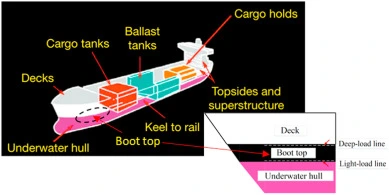Marine Coating Removal in Shipyard
Marine Coating Removal in Shipyard

The shipping industry accounts for transporting 90% of global trade. The current world fleet comprises more than 100,000 merchant vessels, including bulk carriers, tankers, containers, general cargo, ferries, and passenger ships. As illustrated in the photo below, a typical merchant ship comprises distinct areas such as underwater hull, boot top area, decks, ballast tanks, topsides and superstructures, and vessel interiors. Different marine coatings are vital and tailored to protect the ship surfaces from corrosion, heat or fire, and fouling. A coating system typically includes several layers of coatings: a primer coat, one or more intermediate coats, and a topcoat.

Under the protection of the coatings, a ship can operate for a service lifetime of 20–30 years. However, coating degradation and rusting of the vessel surfaces occur during marine transportation, which requires the ship to be docked for repair and maintenance at intervals of 3–5 years. During ship repair, foreign matter on the ship coating surfaces such as oil, grease, salts, attached marine organisms, and slime, are washed down with high-pressure water, followed by the removal of rust and coatings via spot or full blast cleaning.
Abrasive blasting (i.e., grit blasting) uses air pressure, water pressure, or centrifugal force to propel a high-velocity stream of an abrasive against a surface to remove rust, mill scale, dirt, and old paints, and to create a rough surface profile. Nonabrasive blasting removes surface contaminants and coatings without the use of abrasives. However, it cannot create a surface profile, and therefore, it is primarily used for an old profiled surface rather than new steel surfaces.
For many years, dry abrasive blasting has been the most efficient and economical method applied on large surfaces to remove old paints, rust, and other impurities. Photo (a) illustrates the simple working mechanism of the most used air pressure blasting, wherein compressed air is used to propel abrasive materials to the workpiece. Air pressure blasting is used in an open-air environment because the vessels are too large for an indoor facility. Abrasive media such as natural minerals (e.g., garnet and olivine), metallic grits, coal slag, copper slag, and other metallurgical slags have been commonly used after the ban of silica sand because of silicosis. In this process, a large amount of solid waste is generated, which consists of contaminated abrasives and paint chips. Further, open-air dry abrasive blasting has an increasing challenge in terms of compliance with state and local health and environment regulations. To this end, efforts have been invested to reduce dust emissions, including the application of vacuum blasting, the use of dust suppressants, and the development of (semi-)automatic systems. Government and local regulations increasingly restrict the use of open-air dry blasting, thereby motivating the development of new technological solutions such as finding alternative blast media and techniques.

Wet abrasive blasting methods were developed to reduce dust emissions and waste generation. Wet abrasive methods used in the ship repair industry can be divided into two categories: air abrasive blasting with water addition (i.e., vapor blasting or slurry blasting), and water blasting with abrasive addition (i.e., hydraulic blasting). In hydraulic blasting (Photo (b)), high-pressure water (200–700 bar) is used to drive the abrasives to the surface. In contrast, in slurry blasting (Photo (c)), fine abrasives suspended in a liquid are projected at a high velocity by a jet of compressed air, or less commonly, a high-pressure centrifugal pump. Compared to hydraulic blasting, slurry blasting is ‘gentler’, achieve a finer finish, and has lower water consumption. However, compared with the dry abrasive method, both techniques generate an extra waste stream, i.e., wastewater.
Another popular wet blasting method is water blasting without any abrasives, which is called water jetting. Ultrahigh pressure (UHP) water jetting is one of the fastest-growing surface preparation methods used in ship repair yards. In UHP water jetting (Photo (d)), the UHP pump pressurizes freshwater into an ultrahigh-pressure (typically 2000 bar as a minimum) stream and then passes it through rotary nozzles with small orifices, forming an intensive blasting stream to remove old paints, rust, and other surface contaminants. The system is usually equipped with a vacuum suction system to collect wastewater and waste paint chips. Without the use of abrasive media, the amount of waste generated is greatly reduced. Nevertheless, an on-site water recycling system is important for the sustainable utilization of freshwater.
Other techniques such as dry ice blasting, cryogenic N2 jetting, plasma depainting, and laser depainting have been developed and are being increasingly applied in the coating removal process to minimize waste generation.
Welcome to visit our website www.cnbstec.com for more information.













